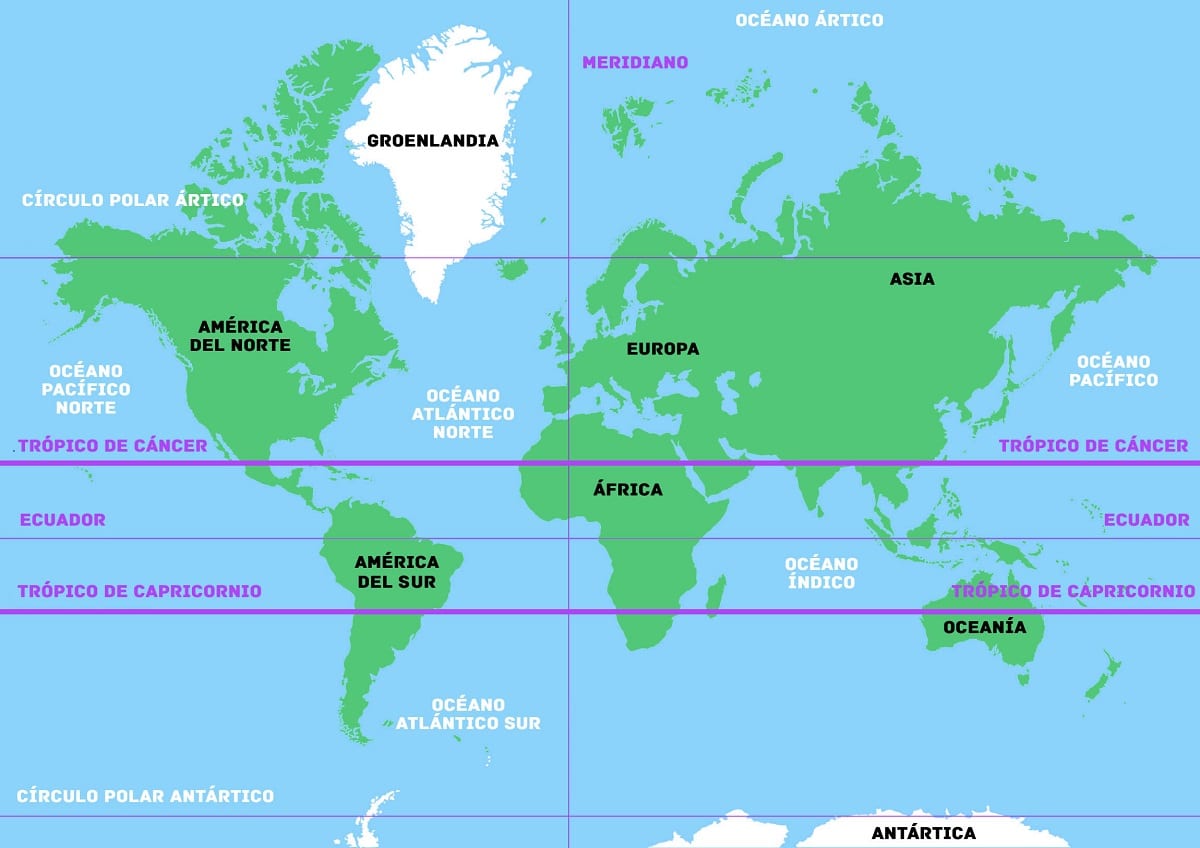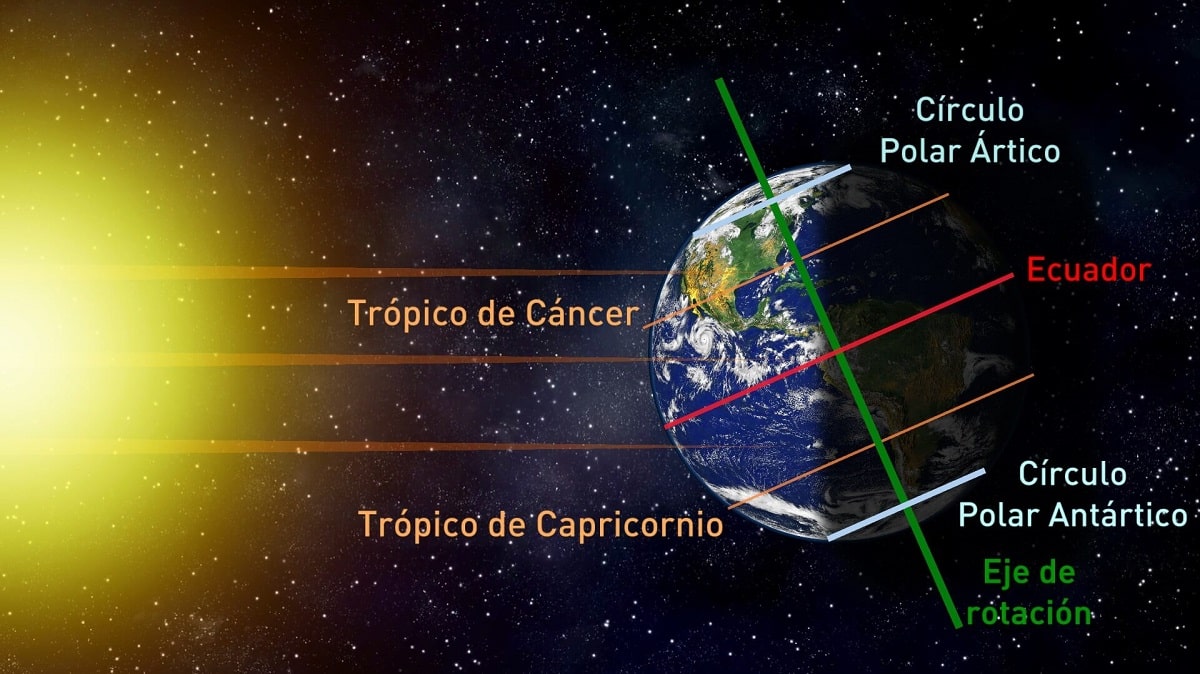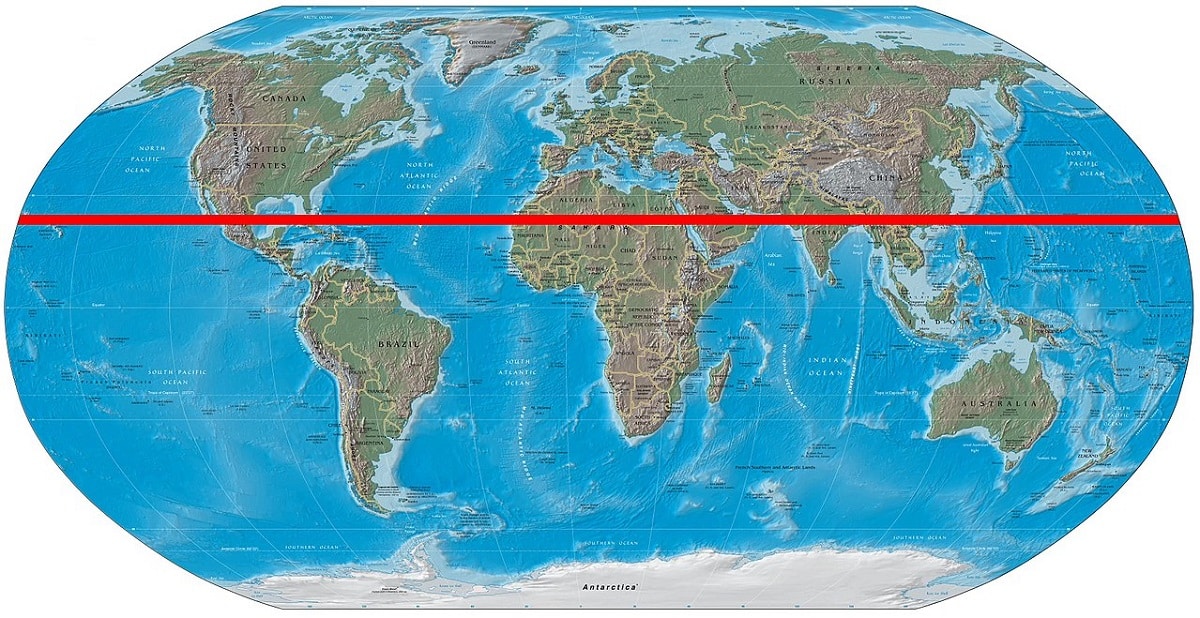
Human beings have delimited imaginary lines on our planet in order to establish the latitudes and dimensions of countries and continents. These latitudes are divided into north, south, east and west. The line that separates north from south is called Ecuador and leaves the planet divided into what are called the tropics of earth. We have the Tropic of Capricorn and the Tropic of Cancer.
In this article we are going to tell about what are the main characteristics of the tropics of the Earth and what is the important one that they have.
Earth Tropics

The tropics are lines parallel to the equator, 23º 27' from the equator in both hemispheres. We have the Tropic of Cancer to the north and the Tropic of Cancer to the south.
The equator is the line with the largest diameter. It is perpendicular to the Earth's axis at its midpoint. The largest circle on the earth, perpendicular to its axis, divides the earth into two equal parts called hemispheres: north or north (northern hemisphere) and south or south (southern hemisphere). The terrestrial longitudes form great circles perpendicular to the terrestrial equator and pass through the poles.
Perpendicular to the equator, an imaginary infinite circle can be drawn around the Earth, the diameter of which coincides with the polar axis. these circles They are made up of two semicircles called meridians and antimeridians., respectively. The characteristics of the meridians are the following:
- They all have the same diameter (earth axis).
- They are perpendicular to the equator.
- They contain the center of the earth.
- They converge at the poles.
- Together with their corresponding anti-meridians they divide the Earth into two hemispheres.
Tropic of Capricorn

The Tropic of Cancer is an imaginary horizontal or parallel line that rotates around the Earth at 23,5° south of the equator. It is the southernmost point on Earth, extending from the southernmost point to the north of the Tropic of Cancer, and is responsible for marking the southern end of the tropics.
The Tropic of Capricorn is so named because the Sun is in Capricorn during the December solstice. The Appointment took place about 2000 years ago, when the sun was no longer in these constellations. At the June solstice, the Sun is in Taurus, and at the December solstice, the Sun is in Sagittarius. It is called Capricorn because in ancient times, when the summer solstice occurred in the southern hemisphere, the sun was in the constellation of Capricorn. It is currently in the constellation of Sagittarius, but tradition still accepts the name Tropic of Capricorn by tradition.
The characteristics are as follows:
- Seasonal differences in the tropics are minimal, so life is generally warm and sunny in the Tropics of Capricorn.
- The cold peaks of the Atacama and Kalahari deserts, Rio de Janeiro and the Andes are located in the Tropic of Capricorn.
- This is where the vast majority of the world's coffee is grown.
- This is an imaginary line that determines the furthest point south that the sun can reach at noon.
- It is responsible for delineating the southern limits of the tropics.
- The first place it starts is on the desert coast of Namibia, in Sandwich Harbour.
- The tropics cross the Limpopo River, a large canal that runs through South Africa, Botswana, and Mozambique and empties into the Indian Ocean.
- The Tropic of Capricorn only touches the northernmost province of South Africa, but includes the Kruger National Park.
Tropic of Cancer

The Tropic of Cancer is the line of latitude that encircles the Earth at about 23,5° north of equatorial latitude. This is the northernmost point on Earth. Also, it is one of the five main measurements taken in units of latitude, or circles of latitude, that divide the Earth, remember that the other measurements are Capricorn, Equator, Arctic Circle and Antarctic Circle.
The Tropic of Cancer is very important for the branch of geography that studies the Earth, because in addition to being the northernmost point that directly shows the sun's rays, it also has the function of marking the northern end of the tropics, extending north from the equator to the Tropic of Cancer and south to north of the regression line. The Tropic of Cancer is the line of latitude that circles the earth at 23,5° north of equatorial latitude, it is the northernmost point of the Tropic of Cancer and one of the degrees used to divide the earth.
During the June or summer solstice, the sun points to the constellation of Cancer, so the new line of latitude is called the Tropic of Cancer. But it must be mentioned that the name was given more than 2000 years ago, and the sun is no longer in Cancer. It is currently in the constellation of Taurus. However, for most references, the latitude position of the Tropic of Cancer at 23,5°N is easier to understand. Their characteristics are:
- It is the northernmost latitude where the sun can appear directly overhead, and it occurs during the famous June solstice.
- To the north of this line, we can find subtropical and northern temperate zones.
- South of the Tropic of Cancer and north of Capricorn it is tropical.
- Its seasons are not marked by temperature, but by a combination of trade winds that draw moisture from the ocean and produce seasonal rains called monsoons on the East Coast.
- Different types of climate can be distinguished in the tropics because latitude is only one of many factors that determine tropical climate.
- It contains the largest area of humid tropical forest in the world.
- It is responsible for delimiting the northern limit of the vertical line between the sun and the earth during the summer solstice of the northern hemisphere.
As you can see, the human being has used imaginary lines to be able to divide the planet according to climatic characteristics and it is very useful for cartography and geography. I hope that with this information you can learn more about the tropics of the Earth and its characteristics.